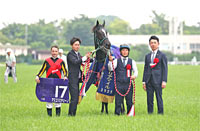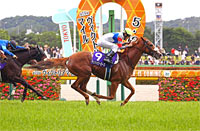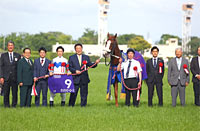Victoria Mile (G1) - Data Analysis
Spring champion decider for 4yo & up fillies & mares known for "extreme" payouts
In last year’s Victoria Mile, the runners backed as 5th favorite or higher were all beaten to 4th or lower, resulting in a substantial Trifecta payout of 918,700 yen. In addition, the 2015 race produced the second highest Trifecta payout in JRA history (at the time), at 20,705,810 yen, showing that upset victories are not uncommon in this race. On the other hand, the 2011 race registered the sixth lowest Trifecta payout for a flat G1 race in JRA history (at the time), at 3,620 yen. While the Victoria Mile has seen strong showings by unfavored runners, there have also been many cases of established runners performing in line with their favoritism, making the race extremely difficult to predict. This time, let’s analyze some features shared by successful runners in this race based on results over the last 10 years.
Strong showings by runners that have enjoyed success in left-handed G1 race since the previous year
Of the 30 Top 3 finishers in the last 10 years, 15 had experienced a Top 3 finish in “a left-handed JRA G1 race since the previous year.” Such runners achieved an excellent Top 3 ratio of 44.1%. If any of this year’s runners have enjoyed success in a G1 race at Tokyo or Chukyo Racecourse since 2017, we should check them out. [Table 1]
[Table 1] Performance by experience of finishing in Top 3 of “a left-handed JRA G1 race since the previous year” (last 10 years)
| Experience |
Performance
[1st-2nd-3rd-4th or lower] |
Win ratio |
Top 2 ratio |
Top 3 ratio |
| Yes |
8-5-2-19 |
23.5% |
38.2% |
44.1% |
| No |
2-5-8-129 |
1.4% |
4.9% |
10.4% |
In addition, among runners that had not experienced a Top 3 finish in “a left-handed JRA G1 race since the previous year,” those that had also not experienced a Top 5 finish in “a 1,400-1,800m JRA graded race in the same year” struggled with a Top 3 ratio of 1.4%. Among runners that lack this kind of record in a major left-handed race, we should focus on performance in graded races of approximately a mile held in the same year. [Table 2]
[Table 2] For runners that had not experienced a Top 3 finish in “a left-handed G1 JRA race since the previous year,” performance by experience of finishing in Top 5 of “a 1,400-1,800m JRA graded race in the same year” (last 10 years)
| Experience |
Performance
[1st-2nd-3rd-4th or lower] |
Win ratio |
Top 2 ratio |
Top 3 ratio |
| Yes |
2-5-7-59 |
2.7% |
9.6% |
19.2% |
| No |
0-0-1-70 |
0% |
0% |
1.4% |
Check grade of previous race
Of the 30 Top 3 finishers in the last 10 years, 20 had contested “a G1 or G2 race in Japan or overseas” last time out. Essentially, the focus for this race should be on runners that have entered a high-grade race in their previous race. [Table 3]
[Table 3] Performance by condition of previous race (last 10 years)
Condition of
previous race |
Performance
[1st-2nd-3rd-4th or lower] |
Win ratio |
Top 2 ratio |
Top 3 ratio |
| G1 or G2 race in Japan or overseas |
9-6-5-79 |
9.1% |
15.2% |
20.2% |
| Other race |
1-4-5-69 |
1.3% |
6.3% |
12.7% |
However, if we narrow down our analysis to runners that had contested “a G1 or G2 race in Japan” in their last outing, we find that those backed as “7th favorite or lower” in that race were all beaten to 4th or lower. Among runners that have entered a high-grade race in their last outing, we should not expect too much from those that were not backed by high favoritism in that race. [Table 4]
[Table 4] For runners that had contested "a G1 or G2 race in Japan" in their last outing, performance by favoritism in that race (last 10 years)
Favoritism in
previous race |
PerformanceFinish
[1st-2nd-3rd-4th or lower] |
Win ratio |
Top 2 ratio |
Top 3 ratio |
| 6th favorite or higher |
7-4-5-44 |
11.7% |
18.3% |
26.7% |
| 7th or lower |
0-0-0-33 |
0% |
0% |
0% |
In addition, among runners that had contested their previous race in “a non-G1/G2 race in Japan or overseas,” those that finished 6th or lower in that race struggled with a Top 3 ratio of 3.4%. Among runners that have contested a G3 or lower-grade race in their previous outing, those that finished 5th or higher in that race should be rated higher. [Table 5]
[Table 5] For runners that had contested a "non-G1/G2 race in Japan or overseas" in their previous outing, performance by finish in that race (last 10 years)
| Finish in previous race |
Performance
[1st-2nd-3rd-4th or lower] |
Win ratio |
Top 2 ratio |
Top 3 ratio |
| 5th or higher |
1-3-5-41 |
2.0% |
8.0% |
18.0% |
| 6th or lower |
0-1-0-28 |
0% |
3.4% |
3.4% |
Discount runners without much interval between races
Looking at runners over the last 10 years in terms of the period elapsed since their previous race, we note that runners that had contested their previous race "two weeks or less" before the Victoria Mile produced zero winners and achieved a Top 3 ratio of only 8.2%. Incidentally, in the first (2006) and second (2007) Victoria Mile races, runners that had contested their previous race two weeks or less before were all beaten to 4th or lower. Runners that have contested a race since late April, such as the Fukushima Himba Stakes, are likely to struggle. [Table 6]
[Table 6] Performance by period elapsed since previous race (last 10 years)
| Interval since previous race |
Performance
[1st-2nd-3rd-4th or lower] |
Win ratio |
Top 2 ratio |
Top 3 ratio |
| Two weeks or less |
0-2-2-45 |
0% |
4.1% |
8.2% |
| Three weeks or more |
10-8-8-103 |
7.8% |
14.0% |
20.2% |
Front runners in previous race have dominated in recent years
Looking at performances by runners that entered the Victoria Mile in the last six years and had contested their previous race in Japan in terms of their position when passing the 4th corner in that race, we find that those positioned “3rd or higher” achieved a Top 3 ratio of 31.6%, reflecting excellent performance in comparative terms. Meanwhile, runners positioned “10th or lower” struggled somewhat with a Top 3 ratio of 6.7%. If trends in recent years are anything to go by, runners that led the pack in their previous race should be rated highly. [Table 7]
[Table 7] Performance by position at 4th corner for runners whose previous race was contested in Japan (last six years)
Position at 4th corner
in previous race |
Performance
[1st-2nd-3rd-4th or lower] |
Win ratio |
Top 2 ratio |
Top 3 ratio |
| 3rd or higher |
3-2-1-13 |
15.8% |
26.3% |
31.6% |
| 4th-9th |
1-4-5-47 |
1.8% |
8.8% |
17.5% |
| 10th or lower |
2-0-0-28 |
6.7% |
6.7% |
6.7% |
Expect little from runners that won previous race
Looking at performances by runners that entered the Victoria Mile in the last six years by finish in their previous race, we find that runners that had finished "1st" in their previous race struggled with a Top 3 ratio of 3.8%. In 2011 and before, runners that had performed well in warmup races often enjoyed success. However, we note that this has not been the case in recent years, even for runners backed by high favoritism. [Table 8]
[Table 8] Performance by finish in previous race (last six years)
| Finish in previous race |
Performance
[1st-2nd-3rd-4th or lower] |
Win ratio |
Top 2 ratio |
Top 3 ratio |
| 1st |
0-1-0-25 |
0% |
3.8% |
3.8% |
| 2nd or lower |
6-5-6-64 |
7.4% |
13.6% |
21.0% |
Seek out the winner
Track record in G1 races and warmup races are key points
The last six winners had all experienced a Top 5 finish in "a JRA G1 race since the previous year." Among this year's runners, therefore, we need to discount those that were unable to rise to the top in a big race since 2017. Moreover, other features shared by the six winners are that they had all been backed as 5th favorite or higher in their previous race, that the interval since their previous race was four weeks or more, and that they had finished their previous race 2nd or lower. Accordingly, we should also keep an eye on the trends outlined in Tables 3, 4, 5, 6 and 8. [Table 9]
[Table 9] Winners' performance by "highest finish in JRA G1 race since previous year," "favoritism in previous race," "period elapsed since previous race," and "finish in previous race" (last six years)
| Year |
Winner |
Highest finish in JRA G1 race since previous year
|
Favoritism in previous race |
Period elapsed since previous race |
Finish in previous race |
| 2012 |
Whale Capture |
2nd (2011 Oka Sho (Japanese 1000 Guineas)) |
2nd |
8 weeks |
5th |
| 2013 |
Verxina |
2nd (2012 Queen Elizabeth II Cup, etc.) |
4th |
5 weeks |
6th |
| 2014 |
Verxina |
1st (2013 Victoria Mile) |
5th |
4 weeks |
11th |
| 2015 |
Straight Girl |
2nd (2014 Sprinters Stakes) |
1st |
6 weeks |
13th |
| 2016 |
Straight Girl |
1st (2015 Sprinters Stakes, etc.) |
3rd |
4 weeks |
9th |
| 2017 |
Admire Lead |
5th (2016 Oka Sho (Japanese 1000 Guineas)) |
3rd |
4 weeks |
2nd |
(Masaya Ibuki) |



















